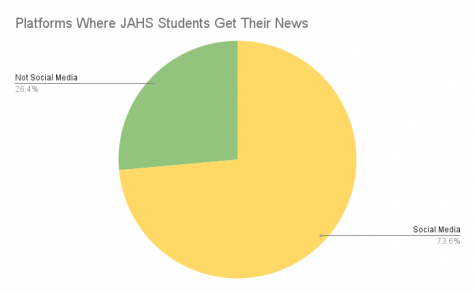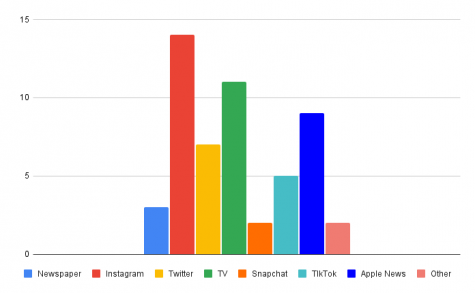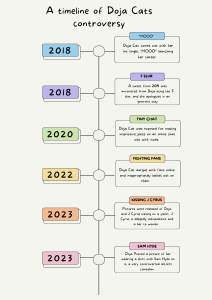Social Media’s Increasing Effect on Teen News
September 23, 2021
“That’s where I always am, and that’s what everyone uses.”
This was Junior Nora Sheridan’s response when asked why Instagram was where she primarily got her news from. Unfortunately, with the limited attention span and easy accessibility, this is the reality of many high school students. But, can we really trust this as a reliable source? Are we getting all the facts, or just what we want to see?
When asked what their primary news source was in a survey of 53 students, 73.6% responded with some form of social media platform. The top platforms included Instagram, Twitter, and TikTok. Of the 26.4% who do not use social media as their first choice for current events, the majority use TV news channels. Given that most teens carry their cellphones around with them, this is not very difficult to believe. But, with modern technology, it brings to question the reliability of social media and what we are seeing.
“I classify news as what’s actually happening, but social media always blows it way out of proportion,” Junior Mike Polsinelli says.
Social media algorithms, whether we’d like to admit it or not, plague all of our recommended pages. From TikTok to Instagram, everything we see has been filtered and tailored to fit our taste. That’s how we all get so addicted to social media. The University of Arizona defines a social media analytics (algorithms) as “Data that is collected from social media websites and apps that give a clear picture of your online actions and presence.” Now, when just viewing funny videos or vacation pictures, this is not a problem. But, if all of our content is being filtered, can we really base our views and opinions on it? Sophomore Josh Weekly prefers news from news sources rather than social media.

“Sometimes the news is biased,” Weekly states, “but I feel like in general they give the whole idea of a topic [compared to social media].”
Most of the news posted on media platforms are not from credible sources, but rather people or drama channels giving their own opinions without even knowing all the facts themselves. So, if we all can agree that social media sources are biased and unreliable as a sole news source, what can we do to stop this epidemic of misinformation? It seems that a few JAHS students have already found ways to combat this issue. Junior Addison Johnson is one of those students.
“I don’t really tend to take the things social media says to heart,” Johnson claims.”I like to do my own research when I’m truly interested in the topic”.
This is a viable option for all teens who truly want to be informed about the claims and opinions they are forming. It doesn’t take long to look up the LA or New York Times on your phone, and the journalists writing these articles not only have all the facts, but also have to go through an extensive editing process to make sure that what they are putting out is the truth. As with anything written, said, or thought by any human being, there will be a small amount of bias, but you will see a lot less of it then you would on someone’s private story.
“Sometimes I think people can be blinded by the fact that they think something is all fact,” says Junior Madeleine Freyhof, “but because of bias there’s a lot of opinion in an article. Overall I think people need to form their own opinions separate from what social media or other news sources tell them.”








